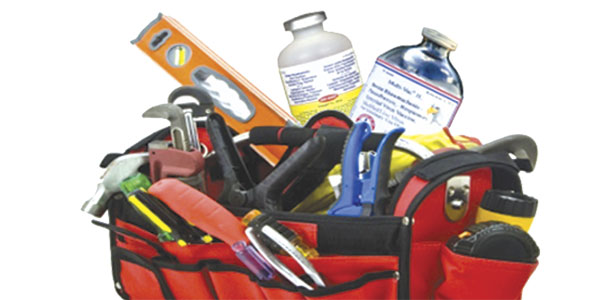Dr. Grooms, president of the American Association of Bovine Practitioners, defined what vaccines do for our cattle and the industry, the types of vaccines and how to properly store and administer vaccinations in a webinar he led Jan. 13 titled “Basic Vaccinology: Why Vaccines Work or Don’t Work.”
Grooms began his lecture by stating that while vaccines are a valuable tool that can be used to decrease the incidence of disease and sickness, vaccines should represent just one tool in a farmer’s toolbox. Vaccine programs should be used in conjunction with biosecurity protocols, good management and proper sanitation.

Vaccines are substances designed to stimulate an immune response from the animal. When an animal is exposed to a harmful pathogen, their immune system is ready and able to respond. However, it’s crucial to remember that no vaccine is 100 percent effective in preventing a disease or sickness and should not be the only preventative measure taken on the farm.
Creating and implanting an effective vaccine program on the farm should be a top priority for all dairy and beef farmers. Vaccine programs require farmers to address many issues within the herd and construct a plan that will solve problems and push the herd to future success.
The first step in creating a program is establishing and reviewing the goals of the farm and the problems that need to be solved in order to reach those goals.
When choosing what types of vaccines should be administered, farmers should also research the vaccination programs of neighboring farms. This will give you insight into other sickness and disease in your region. Remember that these pathogens can find a way into your herd as well.
There are many different types of vaccines available on the market and each provides the farmer with varied prices, functions, risks and advantages. Four of the most commonly used vaccines include: attenuated, killed, toxoids and autogenous.
1. Attenuated: These are also known as modified live or live vaccines. They contain live replicating organisms that have been altered and have a greatly reduced chance of causing disease. This type of vaccine most closely simulates a natural infection and develops a more effective immunological response.
However, these vaccines present a risk and can potentially cause pathology in some cases. Attenuated vaccines are also generally the cheapest type to purchase.
2. Killed: These vaccines contain killed bacteria. The key with a killed virus is that the organism still looks the same to the immune system and the antigenic integrity of the bacteria is not altered or eliminated.
Killed vaccines are generally safer and more stable than attenuated because there is no chance of disease due to a virulent organism. Disadvantages to this type of vaccine include a higher price and a greater risk of hypersensitivity (allergic) reactions.
3. Toxoids: The major virulence factor of some bacteria that cause disease are toxins. Toxoids vaccinate against these toxins.
4. Autogenous vaccines: These are formulated by veterinarians to treat pathogens specific to your farm. Autogenous vaccines can only be used on the farm for which they are created.
Once a vaccination program is created and implemented, if farms do not see improvement in their herd health, they need to review the program and pinpoint their downfalls. In most cases, vaccine failure can be separated into two categories: incorrect administration and correct administration with improper handling.
When administering vaccines, follow label directions very strictly. Comply with the instructions that are outlined for dosage, how and where to administer in the animal, when to administer and the withdrawal period.
If the vaccine is being administered correctly but is not responding in the body, there is another issue present within your program. Pharmaceutical companies report that poor vaccine handling is the leading reason for low vaccine responses. It is crucial to remember that vaccines are biological in nature and are very sensitive to their environment.
• Vaccines should be stored in a refrigerator that is set at 40ºF. Thermometers should be placed to monitor temperatures inside older refrigerators. Vaccines should never be frozen.
• When administering vaccines within the herd, they should be transported in a cooler and stored in the cooler in the working area.
• Protect vaccines from UV light.
When administering vaccines, the handling of needles and syringes can be just as important as the vaccine.
• Protect vaccines from contamination from dirty needles. Do not use the same needle to draw different types of vaccines from different bottles.
• Keep syringes and needles away from heat. Administering vaccines from hot syringes or needles renders the vaccine useless by essentially “cooking” the vaccine.
• Never use disinfectants on syringes and needles. Only use hot water and allow to air-dry. Residues from disinfectants can alter the vaccine and greatly reduce its efficiency.
Other reasons for vaccine failure include the following:
• Choosing the wrong vaccine to prevent the disease
• Overwhelming pathogen exposure within the herd due to poor sanitation
• The animal fails to respond due to a variety of reasons, such as immunosuppression, genetics, nutrition. Also, cattle close to calving often don’t respond well to vaccinations.
Passive immunity can be a factor with young calves given colostrum very early in life; they don’t respond to vaccines because of the colostrum’s antibodies.
A great example of this is the use of Calf-Guard Rota-Coronavirus. In order for the vaccine to work, it must be administered to the calf at least 30 minutes before colostrum is given. If it is given after the calf has consumed colostrum, the vaccine is rendered worthless and does not prevent the calf from any disease or sickness.
Throughout the webinar, Grooms repeatedly expressed the importance of biosecurity protocols, good management and sanitation. He said a strong foundation that encompasses those three standards will add value and success to a well-planned and implemented vaccination program. PD
Listen to the full webinar .
Sara Kitchen is a Penn State University student and a freelance writer based in State College, Pennsylvania.
PHOTO
Vaccine programs require farmers to address many issues within the herd and construct a plan that will solve problems and push the herd to future success. Image from webinar.
Vaccine Failure
• REMEMBER – Vaccines are not 100% effective
• They are a tool to use in conjunction with other disease control tools
• However, there are things that can reduce efficiency
• Incorrect administration






